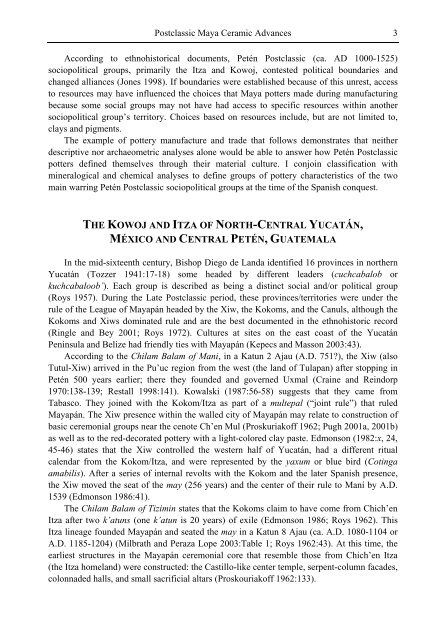Developments in Ceramic Materials Research
Developments in Ceramic Materials Research
Developments in Ceramic Materials Research
You also want an ePaper? Increase the reach of your titles
YUMPU automatically turns print PDFs into web optimized ePapers that Google loves.
Postclassic Maya <strong>Ceramic</strong> Advances 3<br />
Accord<strong>in</strong>g to ethnohistorical documents, Petén Postclassic (ca. AD 1000-1525)<br />
sociopolitical groups, primarily the Itza and Kowoj, contested political boundaries and<br />
changed alliances (Jones 1998). If boundaries were established because of this unrest, access<br />
to resources may have <strong>in</strong>fluenced the choices that Maya potters made dur<strong>in</strong>g manufactur<strong>in</strong>g<br />
because some social groups may not have had access to specific resources with<strong>in</strong> another<br />
sociopolitical group’s territory. Choices based on resources <strong>in</strong>clude, but are not limited to,<br />
clays and pigments.<br />
The example of pottery manufacture and trade that follows demonstrates that neither<br />
descriptive nor archaeometric analyses alone would be able to answer how Petén Postclassic<br />
potters def<strong>in</strong>ed themselves through their material culture. I conjo<strong>in</strong> classification with<br />
m<strong>in</strong>eralogical and chemical analyses to def<strong>in</strong>e groups of pottery characteristics of the two<br />
ma<strong>in</strong> warr<strong>in</strong>g Petén Postclassic sociopolitical groups at the time of the Spanish conquest.<br />
THE KOWOJ AND ITZA OF NORTH-CENTRAL YUCATÁN,<br />
MÉXICO AND CENTRAL PETÉN, GUATEMALA<br />
In the mid-sixteenth century, Bishop Diego de Landa identified 16 prov<strong>in</strong>ces <strong>in</strong> northern<br />
Yucatán (Tozzer 1941:17-18) some headed by different leaders (cuchcabalob or<br />
kuchcabaloob’). Each group is described as be<strong>in</strong>g a dist<strong>in</strong>ct social and/or political group<br />
(Roys 1957). Dur<strong>in</strong>g the Late Postclassic period, these prov<strong>in</strong>ces/territories were under the<br />
rule of the League of Mayapán headed by the Xiw, the Kokoms, and the Canuls, although the<br />
Kokoms and Xiws dom<strong>in</strong>ated rule and are the best documented <strong>in</strong> the ethnohistoric record<br />
(R<strong>in</strong>gle and Bey 2001; Roys 1972). Cultures at sites on the east coast of the Yucatán<br />
Pen<strong>in</strong>sula and Belize had friendly ties with Mayapán (Kepecs and Masson 2003:43).<br />
Accord<strong>in</strong>g to the Chilam Balam of Mani, <strong>in</strong> a Katun 2 Ajau (A.D. 751?), the Xiw (also<br />
Tutul-Xiw) arrived <strong>in</strong> the Pu’uc region from the west (the land of Tulapan) after stopp<strong>in</strong>g <strong>in</strong><br />
Petén 500 years earlier; there they founded and governed Uxmal (Cra<strong>in</strong>e and Re<strong>in</strong>dorp<br />
1970:138-139; Restall 1998:141). Kowalski (1987:56-58) suggests that they came from<br />
Tabasco. They jo<strong>in</strong>ed with the Kokom/Itza as part of a multepal (“jo<strong>in</strong>t rule”) that ruled<br />
Mayapán. The Xiw presence with<strong>in</strong> the walled city of Mayapán may relate to construction of<br />
basic ceremonial groups near the cenote Ch’en Mul (Proskuriakoff 1962; Pugh 2001a, 2001b)<br />
as well as to the red-decorated pottery with a light-colored clay paste. Edmonson (1982:x, 24,<br />
45-46) states that the Xiw controlled the western half of Yucatán, had a different ritual<br />
calendar from the Kokom/Itza, and were represented by the yaxum or blue bird (Cot<strong>in</strong>ga<br />
amabilis). After a series of <strong>in</strong>ternal revolts with the Kokom and the later Spanish presence,<br />
the Xiw moved the seat of the may (256 years) and the center of their rule to Maní by A.D.<br />
1539 (Edmonson 1986:41).<br />
The Chilam Balam of Tizim<strong>in</strong> states that the Kokoms claim to have come from Chich’en<br />
Itza after two k’atuns (one k’atun is 20 years) of exile (Edmonson 1986; Roys 1962). This<br />
Itza l<strong>in</strong>eage founded Mayapán and seated the may <strong>in</strong> a Katun 8 Ajau (ca. A.D. 1080-1104 or<br />
A.D. 1185-1204) (Milbrath and Peraza Lope 2003:Table 1; Roys 1962:43). At this time, the<br />
earliest structures <strong>in</strong> the Mayapán ceremonial core that resemble those from Chich’en Itza<br />
(the Itza homeland) were constructed: the Castillo-like center temple, serpent-column facades,<br />
colonnaded halls, and small sacrificial altars (Proskouriakoff 1962:133).
















